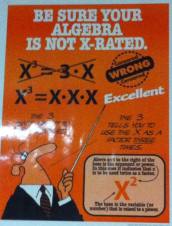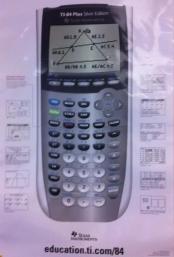Like most of the East Coast, schools here still have quite a ways to go before enjoying summer. I see my students for one more full week before final exam review begins and finals are given; a time which becomes more crazy as I travel to Kansas City for the AP Stats reading (or…Stats Christmas in June!)
It’s a starange time of year for AP Stats. The College Board exam was given on May 9, and students took a final exam in my class before then, so we have been done with new material for some time now. With a full 3 weeks (or more) between the exam and the end of the school year, it’s a time to take my foot off the gas from day-to-day material, but I still need to see my kids engaged in statistics. Our culminating event, Stats Fair, provides a chance to highlight our program and keep the statistical ball rolling. There’s really only one requirement for Stat Fair: design a project of your choosing which serves as evidence of your statistical learning. At the Fair, students show off their work to invited guests and fellow students (you can see pictures from previous fairs on my school website). Teams must also provide printed documentation of their project to me. It’s a great opportunity to be creative, study something you are passionate about, and explore something new. There’s just one little problem…
Most student project ideas suck
Yep. After a year of learning about experimental design, the role of randomness, and all sorts of nifty confidence intervals, many of my 17 year-old students will revert back to their 6th grade dopplegangers; proposing scientific studies of their peers’ favorite colors or chocolate chip cookie preference or how much honors’ kids backpacks weigh. Sigh….
Maybe I’m just jaded. I warn the students early-on that it is likely I will reject their first 5 stats fair ideas. It’s not that I am intentionally trying to be mean, rather I want my students to pick something memorable, something they could speak passionately about in front of others. Working with students to develop their concepts could be the most frustrating part of my academic year. Why is it so difficult for students to develop a “good” concept?
- Despite a year full of examples and articles, it’s still a tough leap to the “real world” of teenagers.
- Developing a good concept takes deep thought, revision, patience and reflection; not always teenage qualities.
- The best concepts often contain a high dose of creativity – not something we are always accustomed to in math class.
- It’s the end of the year, and the beach awaits
But all is not lost! Today’s class started with a rousing success: a student, who had earlier proposed a study of NBA player ages (which was going nowhere), finally moved towards one of his passions – music. Using an app on his iphone, he tested the ability of peers to detect high and low pitches in mHz. This led him today to some independent study online of the human ear, and reflection on the data he had gathered.
Another group is using their passion for fashion to see just how “skinny” jeans are these days, comparing waist sizes from different stores. Some interesting data coming from this. Another group is testing the “locally grown produce” claim of supermarkets…neat stuff! And I’m looking forward to the random study of our school’s wireless device access – just how slow is it? It’s the interesting projects which keep me coming back, and make this class memorable – like the team a few years back who entered and won the American Stats Association poster competition with their Bacterial Soap review.
Stats Fair is next Friday. Look forward to sharing pictures and reflections!
 The most recent challenge by the MTBOS (Math-Twitter-Blog-oSphere) is to share what’s on your classroom walls. (Follow the action on twitter, #MTBoS30)
The most recent challenge by the MTBOS (Math-Twitter-Blog-oSphere) is to share what’s on your classroom walls. (Follow the action on twitter, #MTBoS30) In the history of math posters, has any student ever looked at one of these and thought “hey, so THAT’S how you add fractions”…seriously? Sure, these posters are well-intentioned, but they are boring as heck and suck any imagination out of math class. Also, I have to cover them up anytime the SAT comes around.
In the history of math posters, has any student ever looked at one of these and thought “hey, so THAT’S how you add fractions”…seriously? Sure, these posters are well-intentioned, but they are boring as heck and suck any imagination out of math class. Also, I have to cover them up anytime the SAT comes around.


 Go to any math conference and you’ll find gaggles of math teachers walking around the vendor area with swag bags, free stuff the many companies have for you. TI posters are one of the most popular items, and you’ll find many math classrooms sporting these artifacts of math boredom. “It was free, therefore I must place it on my wall”
Go to any math conference and you’ll find gaggles of math teachers walking around the vendor area with swag bags, free stuff the many companies have for you. TI posters are one of the most popular items, and you’ll find many math classrooms sporting these artifacts of math boredom. “It was free, therefore I must place it on my wall”

 So many cool infographics to choose from, so little toner. Love posting these guys all over my room; love it even more when I find kids checking them out just before the bell. But they are a pain to print, and they age badly.
So many cool infographics to choose from, so little toner. Love posting these guys all over my room; love it even more when I find kids checking them out just before the bell. But they are a pain to print, and they age badly.







 Thanks to Mrs. Crocker and her boxed wonderfulness, I can make a tasty cake in just 30 minutes! Eggs, oil and water. And just 3 simple steps: heat – stir – bake. These are some steps I can get behind!
Thanks to Mrs. Crocker and her boxed wonderfulness, I can make a tasty cake in just 30 minutes! Eggs, oil and water. And just 3 simple steps: heat – stir – bake. These are some steps I can get behind!